|
|
First Principles High-throughput Research on Thermoelectric Materials: a Review
LI Xin, XI Li-Li, YANG Jiong
2019 Vol. 34 (3): 236–246
 Abstract
Abstract(
1950 )
 HTML
HTML(
105)
 PDF
PDF(3303KB)(
1970
)
Thermoelectric materials are a kind of energy conversion materials, which are extensively used in power generation or refrigeration. The key parameter that measure the performance of thermoelectric materials is the figure of merit ZT value, which requires material excellent electrical transport performance and low thermal conductivity. Standard first principles calculations on thermoelectric materials focus on small samples of materials, which is difficult to conclude general rules and propose new candidates. The Materials Genome Initiative speeds up the discovery and design of materials based on big data and high-throughput computational methods, which is promising in novel material screening. In thermoelectrics, first principles high-throughput calculations play an increasingly important role in the predicting and designing new materials. However, there are some drawbacks in the current high-throughput efforts for thermoelectric material screening, such as the demand of efficient high-throughput algorithms for transport properties, suitable tools for analyzing big data, etc. Solving these challenges strongly determines the efficiency and accuracy of high-throughput applications in thermoelectrics. This review summarizes several high-throughput theoretical methods and cases study on electrical and thermal transport properties in thermoelectric materials, and prospects the future trend of the combination of high-throughput and thermoelectric material research.
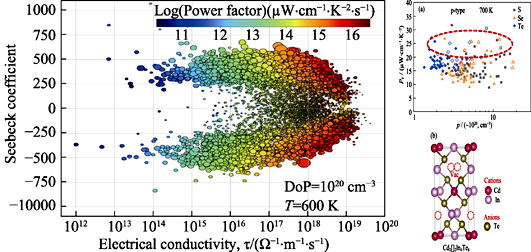
|
|
|
Progress on High-throughput Synthesis and Characterization Methods for Thermoelectric Materials
LUO Jun, HE Shi-Yang, LI Zhi-Li, LI Yong-Bo, WANG Feng, ZHANG Ji-Ye
2019 Vol. 34 (3): 247–259
 Abstract
Abstract(
1327 )
 HTML
HTML(
61)
 PDF
PDF(19246KB)(
1583
)
High-throughput experiments aimed to promptly obtain the relationship among composition-phase-structure-performance with fewer experiments and screen out optimal material systems with optimized compositions. Up to now, high-throughput experiments are successfully applied in superconducting materials, fluorescent materials and giant magnetoresistance materials. Thermoelectric materials are functional materials that can realize the direct conversion between thermal energy and electrical energy and can be potentially applied in the fields of thermoelectric power generation and waste heat utilization. However, traditional preparation and characterization methods for thermoelectric materials have disadvantages of time consuming and low efficiency. Therefore, it is of great theoretical and practical significance to introduce methods and concepts of high-throughput experiments into development and optimization of new thermoelectric materials. In this paper, we summarize and discuss the existing high-throughput experimental preparation and characterization techniques with great application prospects in thermoelectric materials, including high-throughput sample preparation, composition-structure, and electro-thermal transport properties characterization, and then analyze the advantages and limitations of these high-throughput techniques. We hope to provide a reference for future high-throughput optimization and screening of thermoelectric materials.
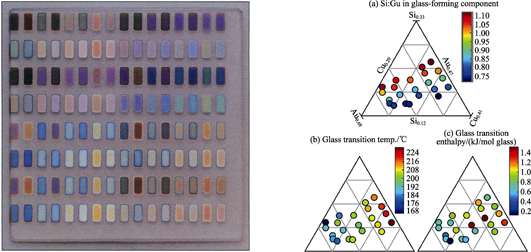
|
|
|
Lattice Thermal Conductivity in Thermoelectric Materials
SHEN Jia-Jun, FANG Teng, FU Tie-Zheng, XIN Jia-Zhan, ZHAO Xin-Bing, ZHU Tie-Jun
2019 Vol. 34 (3): 260–268
 Abstract
Abstract(
3856 )
 HTML
HTML(
157)
 PDF
PDF(4218KB)(
3812
)
With rapid development of sustainable energies and energy conversion technologies, application prospect of thermoelectric (TE) materials in power generation and cooling has received increasing attention. The requirement of improving TE materials with high figure of merit becomes much more important. How to obtain the low lattice thermal conductivity is one of the main concerns in TE materials. In this review, the influences of specific heat, phonon group velocity and relaxation time on the lattice thermal conductivity are discussed, respectively. Several typical features of TE materials with intrinsic low lattice thermal conductivity are introduced, such as strong anharmonicity, weak chemical bonds and complex primitive cells. Introducing multiscale phonon scatterings to reduce the lattice thermal conductivity of known TE materials is also presented and discussed, including but not limited to point defect scattering, dislocation scattering, boundary scattering, resonance scattering and electron-phonon scattering. In addition, some theoretical models of the minimum lattice thermal conductivity are analyzed, which has certain theoretical significance for rapid screening of TE materials with low lattice thermal conductivity. Finally, the efficient ways to obtain the low lattice thermal conductivity for TE property optimization are proposed.
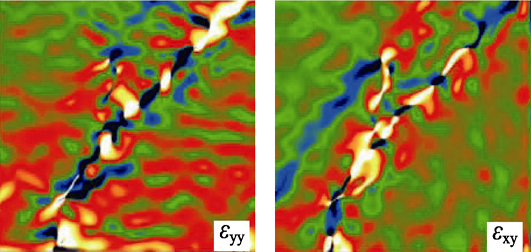
|
|
|
Thermoelectric Device: Contact Interface and Interface Materials
HU Xiao-Kai, ZHANG Shuang-Meng, ZHAO Fu, LIU Yong, LIU Wei-Shu
2019 Vol. 34 (3): 269–278
 Abstract
Abstract(
1833 )
 HTML
HTML(
62)
 PDF
PDF(6045KB)(
2660
)
Thermoelectric power generation via Seebeck effect features an unique advantage in converting large amount of distributed and low-grade waste heat into electricity. Thermoelectric materials have become a hot topic of research in the field of new energy materials, guided by the high figure of merit ZT. Although various mid-temperature thermoelectric materials were discovered, the industrial application of these materials, especially in power generation applications, progressed very slowly. The staggering interface technology associated with thermoelectric device restricted the advance of thermoelectric conversion technology. In this review, the bottleneck issues of utilizing Bi2Te3-based devices for power generation were used as an example to illustrate the critical interface technologies. The key issues at designing electrode contact interfaces were summarized, including low contact resistance, high bonding strength, and superior thermal chemical stability at high temperature. The recent progress on the metallization and interfacial barrier layer for typical materials of Bi2Te3, PbTe and CoSb3 were also reviewed.
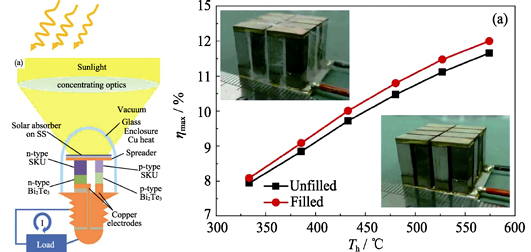
|
|
|
Technologies and Applications of Thermoelectric Devices: Current Status, Challenges and Prospects
ZHANG Qi-Hao, BAI Sheng-Qiang, CHEN Li-Dong
2019 Vol. 34 (3): 279–293
 Abstract
Abstract(
2983 )
 HTML
HTML(
112)
 PDF
PDF(4736KB)(
2213
)
Thermoelectric (TE) power generation technology is highly expected for various applications such as special power supply, green energy, energy harvesting from the environment and harvesting of industrial waste heat. Over the past years, the record of zT values of TE materials has been continuously updated, which would bode well for widespread practical applications of TE technology. However, the TE device as the core technology for the TE application lags behind the development of TE materials. Especially, the large-scale application of TE power generation technology is facing bottlenecks and new challenges. This reviewpresents an overview of the recent progress on TE device design and integration with particular attentions on device optimization design, electrode fabrication, interface engineering, and service behavior. The future challenges and development strategies for large-scale application ofthermoelectric power generation are also discussed.
|
|
|
Optimizing Electrical and Thermal Transport Property in BiCuSeO Superlattice via Heterolayer-isovalent Dual-doping Approach
LI Zhou, XIAO Chong
2019 Vol. 34 (3): 294–300
 Abstract
Abstract(
683 )
 HTML
HTML(
11)
 PDF
PDF(5382KB)(
913
)
Taking the dual-sublayer BiCuSeO superlattice thermoelectric material as an object, equivalent mono- and dual-doped samples were prepared by substitution of Bi and Cu atoms in the corresponding [Bi2O2]2+ sublayer and [Cu2Se2]2- sublayer with isovalent La and Ag atoms. Their thermoelectric properties and the defect modulation mechanism were studied. The results showed that La-Ag dual-doped sample could combine the advantages of mono-doped samples to achieve an relative high carrier mobility while moderately increasing the carrier concentration, thereby maximizing the electrical conductivity. At the same time, it can also induce a potential band convergenceeffect, achieving the low average band effective mass and high density of states effective mass at the same time, which finally endowed Bi0.98La0.02Cu0.98Ag0.02SeO with simultaneous high carrier mobility and Seebeck coefficient, as well as the optimized power factor (PF=σS2). On the other hand, due to the strong point defect scattering on the heat-carrying phonons, the lattice and total thermal conductivities of these isovalent doped samples were further reduced, which finally optimized the figure of merit (ZT). As a result, a high ZT value of 0.46 was achieved at 755K in the La-Ag dual-doped sample, which was superior to that of the pristine sample (0.27 at 755 K) as well as the mono-doped counterparts. Present work demonstrates that heterolayer-isovalent dual-doping with La/Ag equivalent atoms in BiCuSeO can synergistically modulate its thermoelectric transport parameters with significantly improved thermoelectric performance.
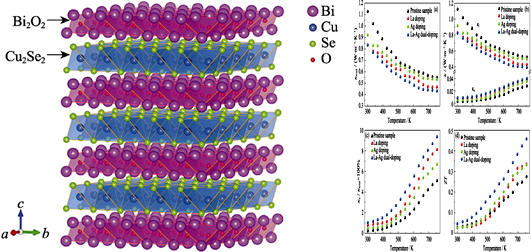
|
|
|
Different Doping Sites of Ag on Cu2SnSe3 and Their Thermoelectric Property
ZHOU Yi-Ming, ZHOU Yu-Ling, PANG Qian-Tao, SHAO Jian-Wei, ZHAO Li-Dong
2019 Vol. 34 (3): 301–309
 Abstract
Abstract(
687 )
 HTML
HTML(
9)
 PDF
PDF(1130KB)(
1082
)
Thermoelectric materials enable the direct inter-conversion between electrical energy and thermal energy. However, the conversion efficiency is limited by complex interdependent thermoelectric parameters, while the high performance thermoelectrics should simultaneously possess excellent electrical transport properties and poor thermal conductivities. The diamond-like compound Cu2SnSe3 is a promising middle-temperature thermoelectric material. In this work, the phase (Cu2Sn0.93Ag0.07Se3) with excellent electrical transport properties and the phase (Cu1.91Ag0.09SnSe3) with poor thermal conductivities were obtained just through Ag doping on the Sn and Cu sites, respectively. Meanwhile, their Seebeck coefficients were also quite different. To combine their advantages, the composites of Cu2Sn0.93Ag0.07Se3 and Cu1.91Ag0.09SnSe3 were fabricated through mechanical mixing and sintering. Benefited from the same crystal structure and the similar lattice parameters for these two phases, the small-mismatch phase interface is supposed to scatter phonons with little influence to the electrons, especially at high temperature. Therefore, the thermoelectric performance is improved due to the synergistically optimized electrical and thermal transport properties, which are well supported by the effective media theory for the composite.
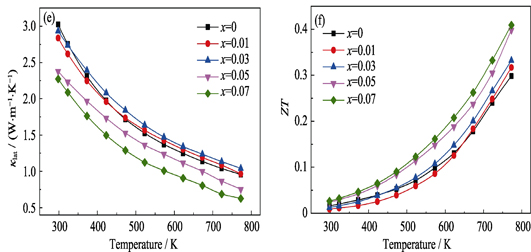
|
|
|
Thermoelectric Property of Zn-Sb Doped Mg2(Si,Sn) Alloys
YU Guan-Ting, XIN Jia-Zhan, ZHU Tie-Jun, ZHAO Xin-Bing
2019 Vol. 34 (3): 310–314
 Abstract
Abstract(
622 )
 HTML
HTML(
16)
 PDF
PDF(627KB)(
942
)
As a type of medium-temperature thermoelectric materials, Mg2(Si,Sn) alloy thermoelectric materials have been widely concerned because of the low cost and environmental friendliness. Heavily Sb doping can effectively induce Mg vacancy so as to reduce the thermal conductivity in Mg2(Si,Sn)-based materials, but at the same time lead to a decrease of Seebeck coefficient. In this study, high-quality Mg2.12-ySi0.4Sn0.5Sb0.1Zny (y=0-0.025) samples were successfully synthesized by high temperature melting and vacuum hot-pressing method. Zn element was introduced into the heavily Sb-doped Mg2(Si,Sn) material to investigate the double doping effect on the electroacoustic transport properties. The results show that Zn-Sb double doping could effectively reduce the total thermal conductivity of Mg2(Si,Sn)-based materials by obviously suppressing the electronic thermal conductivity and at the same time enhance the Seebeck coefficient of Zn-doped samples, so as to compensate for the loss of electrical conductivity, and maintain high electrical performance. Significantly optimized thermal conductivity and electrical performance ultimately improve the thermoelectric figure of meritZT of the material. At 823 K, the maximum ZT of Mg2.095Si0.4Sn0.5Sb0.1Zn0.025 reached 1.42.
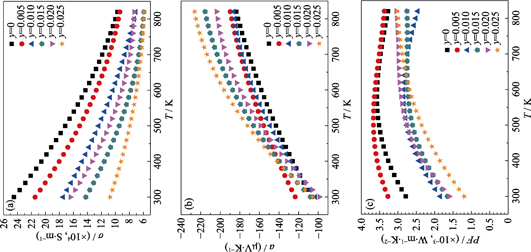
|
|
|
High Thermoelectric Performance of SnTe from the Disproportionation of SnO
HU Hui-Shan, YANG Jun-You, XIN Jin-Wu, LI Si-Hui, JIANG Qing-Hui
2019 Vol. 34 (3): 315–320
 Abstract
Abstract(
718 )
 HTML
HTML(
37)
 PDF
PDF(882KB)(
1178
)
PbTe-based compositions are considered as excellent thermoelectric materials for the mid-temperature. However, the toxicity of lead limits its wide application. SnTe compounds, an analogue of PbTe, has attracted much attention. However, its ultrahigh carrier concentration and the large lattice thermal conductivity leads to a low ZT value of SnTe. In this work,thethermoelectric performance of SnTe is synergistically enhanced by introduction of Sn and SnO2 from the disproportionation of SnO in the process of the hot press sintering. On the one hand, Sn can compensate the Sn vacancies and decrease the carrier concentration of SnTe, leading to a simultaneous enhancement on resistivity and the Seebeck coefficient. For instance, compared with the pristine SnTe, resistivity and the Seebeck coefficient increases from 6.5μΩ•m to 10.5μΩ•m and from 105μV•K-1 to 146μV•K-1,respectively, for the sample of SnTe-6mol% SnO at 873K. On the other hand, in-situ generated SnO2 nanoparticles are dispersedly distributed on the grain boundaries, leading to the multiscale phonon scattering and the reduced lattice thermal conductivity. The minimum lattice thermal conductivity value is 0.6 W•m-1•K-1 for the sample SnTe-6mol% SnO at 873K, which is ~33% reduction compared with that of the pristine SnTe. As a result, the maximum ZT value of 0.96 (~100% enhancement, compared with that of the pristine SnTe) at 873K is achieved for the sample SnTe-6mol% SnO.
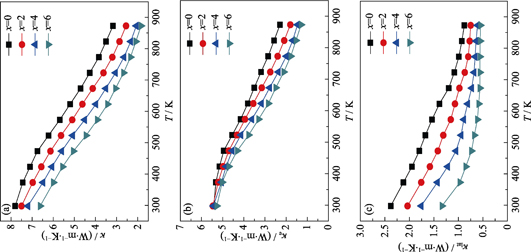
|
|
|
Preparation and Thermoelectric Property of n-type SnS
HUANG Zhi-Cheng, YAO Yao, PEI Jun, DONG Jin-Feng, ZHANG Bo-Ping, LI Jing-Feng, SHANG Peng-Peng
2019 Vol. 34 (3): 321–327
 Abstract
Abstract(
1122 )
 HTML
HTML(
37)
 PDF
PDF(5019KB)(
1364
)
SnS composed of low toxicity, low-cost and earth-abundant elements, has extensive attention in the field of thermoelectric research. The n-type SnS1-xClx (x=0, 0.02, 0.03, 0.04, 0.05, 0.06) polycrystalline bulk thermoelectric samples were prepared by mechanical alloying (MA) combined with Spark Plasma Sintering (SPS). Effect of Cl- amounts on the phase structure, microstructure and thermoelectric transport properties were systematically studied. Results show that introduction of Cl- enhances electron concentration which makes intrinsic p-type SnS change to n-type. With the amount of Cl- increasing, the Hall carrier concentration of n-type SnS semiconductor increases from 6.31×1014cm-3 (x=0.03) to 7.27×1015cm-3 (x=0.06) at room temperature. The maximum electrical conductivity of 408 S•m-1 the relatively high Seebeck coefficient of -553 μV•K-1 are obtained at 823 K for x=0.05 sample, which produces the maximum power factor of 1.2 μW·cm-1·K-2. Addition of Cl- can introduce point defects to scatter phonons, which makes the lattice thermal conductivity reduce from 0.67 W·m-1·K-1 (x=0) to 0.5 W·m-1·K-1 (x=0.02). The highest ZT~0.17 is obtained at 823 K for x=0.04 sample, which is 70% higher than that (ZT~0.1) of the pristine SnS.
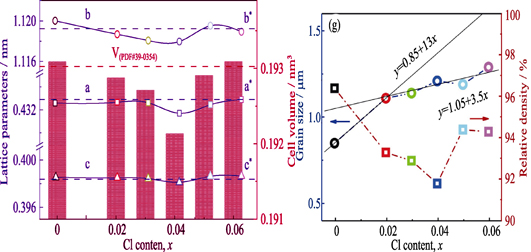
|
|
|
Enhanced Thermoelectric Properties of Hydrothermal Synthesized BiCl3/Bi2S3 Composites
WANG Wei, LUO Shi-Jie, XIAN Cong, XIAO Qun, YANG Yang, OU Yun, LIU Yun-Ya, XIE Shu-Hong
2019 Vol. 34 (3): 328–334
 Abstract
Abstract(
729 )
 HTML
HTML(
21)
 PDF
PDF(6239KB)(
987
)
Hierarchical spherical Bi2S3 particles with nanorod were synthesized by hydrothermal method, and then BiCl3/Bi2S3 composite powders with different molar ratios were consolidated into bulk samples by spark plasma sintering (SPS) technique. The addition of BiCl3 with appropriate amount not only increased the electrical conductivity, but also decreased the thermal conductivity of Bi2S3. The Bi2S3 sample doped with 0.5mol% BiCl3 shows a maximum electrical conductivity of 45.1 S·cm-1 at 762 K, which is much higher than that of pure Bi2S3 at 762 K (12.9 S·cm-1). The minimum thermal conductivity is 0.31 W·m-1·K-1 for the Bi2S3 sample doped with 0.25mol% BiCl3 at 762 K, which is lower than that of pure Bi2S3 (0.47 W·m-1·K-1)at the same temperature. The maximum ZT value of 0.63 at 762 K was achieved by Bi2S3 doped with 0.25mol% BiCl3, which is almost two times higher than that of pure Bi2S3(0.22).
|
|
|
Multi-doping in SnTe: Improvement of Thermoelectric Performance due to Lower Thermal Conductivity and Enhanced Power Factor
TAN Xiao-Fang, DUAN Si-Chen, WANG Hong-Xiang, WU Qing-Song, LI Miao-Miao, LIU Guo-Qiang, XU Jing-Tao, TAN Xiao-Jian, SHAO He-Zhu, JIANG Jun
2019 Vol. 34 (3): 335–340
 Abstract
Abstract(
846 )
 HTML
HTML(
19)
 PDF
PDF(1567KB)(
1099
)
In recent years, tin telluride (SnTe) has attracted considerable interest due to its potential thermoelectric application as a lead-free rock-salt analogue of PbTe. However, pristine SnTe samples show high thermal conductivity and low Seebeck coefficients, resulting in poor thermoelectric performance. In this study, the thermoelectric performance of SnTe was enhanced by well-designed multi-doping, where significantly reduced thermal conductivity and improved Seebeck coefficientswere achieved at the same time. The doped SnTe samples were prepared by hot pressing. The lattice thermal conductivity of SnTe samples is obviously decreased by alloying with Se and S. The transmission electron microscope shows the existence of larger amount of nano-precipitates and the lattice distortions in the alloyed samples. For example, the lattice thermal conductivity of SnTe0.7S0.15Se0.15 sample is reduced to 0.99 W•m-1•K-1 at 300 K. The results reveal that the Seebeck coefficients are improved by introducing In resonant state in the band structure of SnTe. The experiments suggest the effectiveness of designed multi-doping in the thermoelectric performance enhancement of SnTe, and a promising ZT of 0.8 at 850 K is achieved in Sn0.99In0.01Te0.7S0.15Se0.15. The discovery suggests that SnTe is a promising medium-temperature thermoelectric candidate.
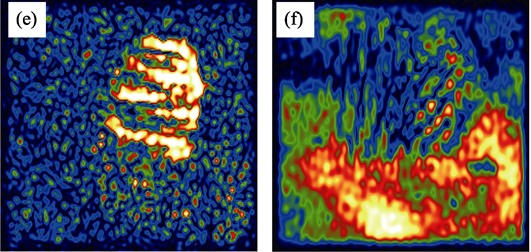
|
|
|
Thermoelectric Properties of (Ag2Se)1-x(Bi2Se3)x
LIU Hong-Xia, LI Wen, ZHANG Xin-Yue, LI Juan, PEI Yan-Zhong
2019 Vol. 34 (3): 341–348
 Abstract
Abstract(
1043 )
 HTML
HTML(
76)
 PDF
PDF(1485KB)(
1549
)
Ternary chalcogenides I-V-VI2 compounds attract extensive attentions for thermoelectric applications due to their intrinsically low lattice thermal conductivity. AgBiSe2, as one of a few n-type semiconductors among these compounds, shows the potential to be a promising thermoelectric material. Therefore, this work focuses on its thermoelectric properties. According to the phase diagram of Ag2Se-Bi2Se3 system, the single phase region of (Ag2Se)1-x(Bi2Se3)x allows x to be varied in the range of 0.4~0.62. This large variation of x suggests a tunability of carrier concentration for this material. A broad carrier concentration of 1.0×1019~5.7×1019 cm-3 for single phased (Ag2Se)1-x(Bi2Se3)x is obtained through a composition manipulation, which enables a comprehensive assessment on electronic transport properties based on a single parabolic band model with acoustic scattering. The highest carrier concentration obtained in this work, approaching to the theoretical optimal one, leads to a peak ZT of 0.5 at 700 K. This work offers a well understanding of its transport properties and underlying physical parameters determining the thermoelectric performance.
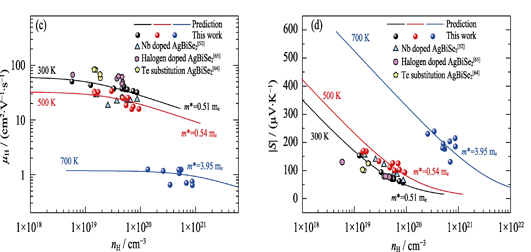
|
|